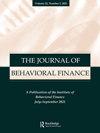Reconciling Self-Assessed with Psychometric Risk Tolerance: A New Framework for Profiling Risk among Investors
IF 1.7
3区 经济学
Q3 BUSINESS, FINANCE
引用次数: 0
Abstract
AbstractFinancial advisors need to assess their clients’ risk profile to properly manage their portfolio risk and comply with regulatory provisions. Assessing an investor’s financial risk tolerance (FRT) is a challenge in the advisory process and none of the existing measures can be easily employed on a large scale. Previous literature has revealed a gap between self-assessed and psychometrically assessed measures of FRT (PA_FRT) but has not yet offered a solution to fill this gap. Thus, we propose a model that consistently estimates the PA_FRT by leveraging retail investors’ self-assessment and other information typically submitted in standard bank questionnaires. Our model represents a promising tool for financial advisors looking to improve their customers’ risk profiling.Keywords: Financial risk toleranceInvestment behaviorInvestor’s preferencesPsychometric measuresSelf-assessmentJEL CLASSIFICATION: C81C83D14D81D83G11 Disclosure statementNo potential conflict of interest was reported by the authors.Notes1 Regulators in Europe and the US have introduced provisions in order to protect investors: Since 2004, the European Markets in Financial Instruments Directive (MiFID) have required investment banks offering financial advice to assess the suitability of retail investors’ portfolios; likewise, since 2010, the US FINRA rule 2111 states that investment firms and their associated persons must have a reasonable basis to believe that a recommended transaction or investment strategy involving securities is suitable for the customer. Assessing a client’s risk profile is therefore a challenge that financial advisors must tackle in their daily activity, both to provide clients with high-quality services and to be compliant with regulatory provisions.2 ESMA (Citation2022), Guidelines on certain aspects of the MiFID II suitability requirements. Paragraph 48: “When assessing the risk tolerance of their clients through a questionnaire, firms should not only investigate the desirable risk-return characteristics of future investments, but they should also take into account the client’s risk perception. To this end, whilst self-assessment for the risk tolerance should be avoided, explicit questions on the clients’ personal choices in case of risk uncertainty could be presented. Furthermore, firms could for example make use of graphs, specific percentages or concrete figures when asking the client how he would react when the value of his portfolio decreases”.3 ESMA (Citation2022) identifies “Defining a client’s risk tolerance solely based on the composition of such client’s existing portfolio” as a poor practice, see page 72.4 The sampling was specifically aimed at ensuring that the overall sample was representative of the entire population of the bank’s customers in terms of socio-demographic characteristics (geographical areas/cities, age), risk profile and financial knowledge. As we refer to a big Italian bank that serves many customers across Italy, our final sample should be representative of Italian retail investors.5 The PA_FRT score has been reparametrized in the scale from 0 to 10 to be comparable with the SA_FRT.6 While our model presents endogeneity, we want to note that the literature on questionnaires commonly applies this kind of methodology to find the best set of items: The same G&L (Citation1999) that we employed in our paper used this method to reduce its original 100 items to 13. What we try to show in Table 4 is that, thanks to other information that the bank has including the SA_FRT, even just having a few of those 13 items we can produce a powerful model.7 In order to obtain a parsimonious model, we performed a stepwise regression with a p-value threshold for inclusion of 0.05.8 The items from the Grable and Lytton (Citation1999) questionnaire are added in the sequential order for maximizing the R-squared of the model.协调自我评估与心理风险承受能力:投资者风险分析的新框架
摘要财务顾问需要评估其客户的风险状况,以正确管理其投资组合风险并遵守监管规定。评估投资者的财务风险承受能力(FRT)是咨询过程中的一个挑战,现有的措施都不容易大规模使用。先前的文献已经揭示了FRT的自我评估和心理测量测量之间的差距(PA_FRT),但尚未提供一个解决方案来填补这一空白。因此,我们提出了一个模型,该模型通过利用散户投资者的自我评估和标准银行问卷中通常提交的其他信息来一致地估计PA_FRT。我们的模型为希望改善客户风险分析的财务顾问提供了一个很有前途的工具。关键词:金融风险承受能力;投资行为;投资者偏好;心理计量措施;注1欧洲和美国的监管机构已经引入了保护投资者的条款:自2004年以来,欧洲金融工具市场指令(MiFID)要求投资银行提供财务建议,以评估散户投资者投资组合的适用性;同样,自2010年以来,美国金融业监管局规则2111规定,投资公司及其关联人员必须有合理的依据相信所推荐的涉及证券的交易或投资策略适合客户。因此,评估客户的风险状况是财务顾问在日常活动中必须应对的挑战,既要为客户提供高质量的服务,又要遵守监管规定ESMA (Citation2022),关于MiFID II适用性要求的某些方面的指南。第48段:“当通过问卷评估客户的风险承受能力时,公司不仅应该调查未来投资的理想风险回报特征,还应该考虑客户的风险感知。为此,在避免对风险承受能力进行自我评估的同时,可以对客户在风险不确定的情况下的个人选择提出明确的问题。此外,当公司询问客户当其投资组合的价值下降时他会如何反应时,公司可以使用图表、具体的百分比或具体的数字ESMA (Citation2022)认为“仅根据客户现有投资组合的构成来定义客户的风险承受能力”是一种不良做法,参见第72.4页。抽样的具体目的是确保总体样本在社会人口统计学特征(地理区域/城市、年龄)、风险概况和金融知识方面代表银行客户的整个人口。当我们提到一家为意大利各地的许多客户提供服务的意大利大银行时,我们的最终样本应该是意大利零售投资者的代表PA_FRT评分在0到10的范围内被重新参数化,与SA_FRT.6相比较虽然我们的模型呈现内生性,但我们要注意的是,关于问卷调查的文献通常应用这种方法来找到最佳项目集:我们在论文中使用的相同的G&L (Citation1999)使用这种方法将其原始的100个项目减少到13个。我们试图在表4中显示的是,由于银行拥有的其他信息,包括SA_FRT,即使只有这13个项目中的几个,我们也可以生成一个强大的模型为了获得一个简洁的模型,我们采用p值阈值逐步回归,纳入0.05.8。Grable和Lytton (Citation1999)问卷中的项目按顺序添加,以最大限度地提高模型的r平方。
本文章由计算机程序翻译,如有差异,请以英文原文为准。
求助全文
约1分钟内获得全文
求助全文
来源期刊

Journal of Behavioral Finance
Multiple-
CiteScore
4.60
自引率
10.50%
发文量
34
期刊介绍:
In Journal of Behavioral Finance , leaders in many fields are brought together to address the implications of current work on individual and group emotion, cognition, and action for the behavior of investment markets. They include specialists in personality, social, and clinical psychology; psychiatry; organizational behavior; accounting; marketing; sociology; anthropology; behavioral economics; finance; and the multidisciplinary study of judgment and decision making. The journal will foster debate among groups who have keen insights into the behavioral patterns of markets but have not historically published in the more traditional financial and economic journals. Further, it will stimulate new interdisciplinary research and theory that will build a body of knowledge about the psychological influences on investment market fluctuations. The most obvious benefit will be a new understanding of investment markets that can greatly improve investment decision making. Another benefit will be the opportunity for behavioral scientists to expand the scope of their studies via the use of the enormous databases that document behavior in investment markets.
 求助内容:
求助内容: 应助结果提醒方式:
应助结果提醒方式:


